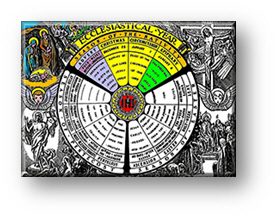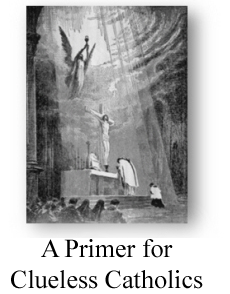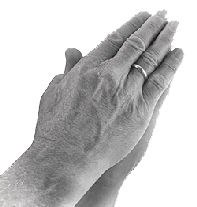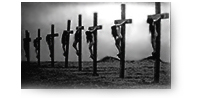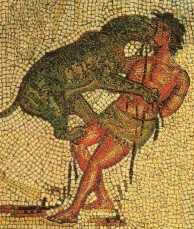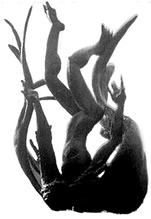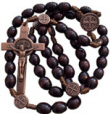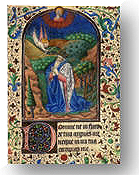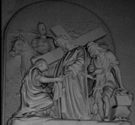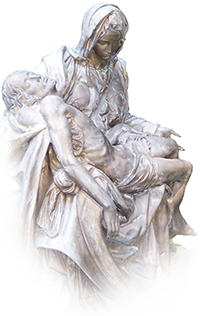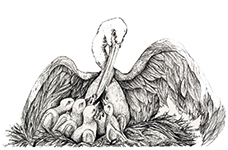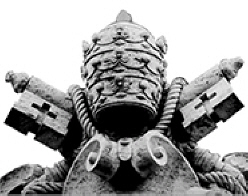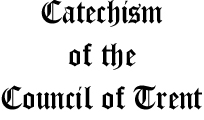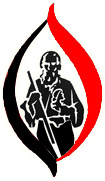|
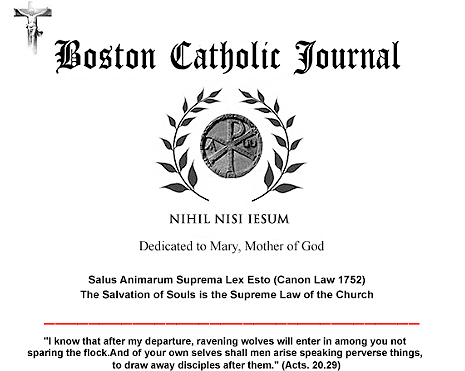
The Tortures and Torments
of the Christian Martyrs
from
De SS. Martyrum
Cruciatibus
(a Modern Edition)
Chapter III
Of the Wooden Horse as an Instrument of
Martyrdom; and Other Sorts of Bonds
That
the Wooden Horse was used as
an instrument of torture is alluded to both by Cicero in the Pro
Deiotaro, the Pro Milone, and the Philippics, and
by other ancient writers such as Valerius Maximus, Quintilian, Seneca,
and Ammianus Marcellinus. We also encounter numerous references to it
in the different Histories and Acts of the Martyrs, especially
those of St. Crescentianus, Sts. Dorothy, Agatha, and Eulalia, Virgins
and Martyrs, Sts. Felix and Fortunatus, Sts. Alexander and Bassus,
Bishops and Martyrs — not to mention
countless others of either sex. In addition to these writers and the
Lives of Saints, we find mention of the Wooden Horse made by
St. Cyprian, in his Epistle to Donatus and elsewhere, by St.
Jerome, St. Augustine, Eusebius, Isidore, and others — as well as by
Prudentius, repeatedly, in his Hymns.
All these agree that the Horse was an ancient instrument of torture
that was used for forcing the truth from suspected or guilty
persons. Cicero, for example, in his Pro Deiotaro, writes:
“By the custom of
our ancestors a slave may bring no charge against his master, even
under examination by torture, when pain can force the truth from
the most unwilling witness. Yet such was the duress brought to bear
on this slave that the man whom he could not so much as name when
on the horse, he openly accused once set free.“ And again, “To elicit
facts, the horse is the proper place; to discuss points of law,
the Court.”
The same may be gathered
from what Ammianus Marcellinus says:
“Though he stood
bent double under the wooden horse, yet he persisted in a stubborn
and uncompromising denial.”
Apart from being used
as a means of extricating the truth from those accused of crimes,
the wooden horse, we find, was equally used as a means for torturing
men and cruelly racking them to the end of punishment — as was
plainly the case with the Christian martyrs. Accordingly we find frequent
mention made of this instrument in the Histories in such recurring
phrases as, “he was tortured on the horse”, “suspended on the horse”,
“hoisted on to the horse”, “put on the horse”, etc.
With regard to the use of the wooden horse as an instrument of torture,
the various writers are all agreed — but not so concerning its precise
description and exact form. For some have declared in so many words
that it was a red-hot plate of metal; others a sort of rack by means
of which a man was suspended with hands tied above his head and with
heavy weights attached to both feet.
Others again, Sigonius
among them, and many religious authors who have followed him, hold it
to have been a sort of wooden framework provided with pulleys and adapted,
alternately, for stretching and relaxing, and intended for torturing
people and compelling them to tell the truth about some circumstance:
“Now the nature of
this torture,“ he says, “was as follows. After binding the arms
and legs of the person to be tortured to this frame by means of
small thongs known as fiddle strings, they then extended the framework
and set it upright, so that the victim found himself suspended upon
it, as on a cross. This done, they proceeded in the first place
to force apart all the joints and articulations of his limbs; then
the placed red-hot plates close to his body, and last of all tore
his sides with two-pronged iron hooks ...”
On the contrary, others
maintain that it was merely a wooden contrivance fashioned something
like a horse (as we will explain further on), having two channeled wheels,
or pulleys, fixed at either end in hollows made to receive them, and
capable of being revolved upon their pins or axles. Over these, ropes
were led in such a way that accused persons could be fastened to them,
and so tortured through being racked and stretched.
These, then, are the various opinions held by different writers concerning
the Wooden Horse. Given this diversity of opinion, we can only arrive
at a genuine understanding of the actual nature of this device if the
evidence is very carefully considered. Upon examining the first of these
opinions, we find it the least compelling . For how can we suppose the
“horse” itself to have been a red-hot plate, when we read in almost
any History of the Martyrs, as well as in the works of other
ancient authors, of men being first hoisted on the horse and
once there, then being burned with red-hot plates.
The second and third opinions
concerning the nature and construction of this device, can also be conclusively
discredited. How possibly can the facts that our predecessors have presented
in their writings about the wooden horse be made to accord with these
conjectures? They cannot. Indeed, we will now demonstrate that the last
quoted opinion alone authentically accords with the facts. This view
may be restated for the sake of clarity as such:
The “horse” in antiquity
was an engine of wood fashioned to resemble a real horse, having
two small, channeled wheels, or pulleys, situated at both ends which
were hollowed out to receive them. Over the axles of these wheels
or pulleys, ropes were led, and the wheels revolved, by which means
the person tied to them was racked and stretched in various directions.
To understand this more
clearly, let us examine how the ancients constructed this device we
call the wooden horse. To begin with, they prepared a straight beam
of wood of a convenient length and breadth; into the two ends of this,
which they had previously hollowed out somewhat, they attached small
channeled wheels that turned upon axles. In order to raise the entire
device above the ground, they used four other pieces of timber, shorter
and thinner than the first, which they then fastened with iron nails
near the four corners, and so constructed a mechanical device standing
on four legs and somewhat resembling a real horse.
Once completed, the victim
to be tortured was placed upon its back and had his two legs forcibly
drawn apart. The tormentors then took ropes, one binding the tied the
man’s feet, and the other his hands after they had twisted the latter
behind him. Next, leading these ropes over the small wheels or pulleys
and carrying them to a small device much like a winch or windlass (we
conjecture) that was attached to the “horse’s legs, they wound the ropes
around it and turning it round, drew the bonds taut in such a way that
the man, tied with his back to the horse’s back and his face looking
skywards, was then stretched along with them. Thus they would continue
turning the winch, drawing the ropes tighter and tighter, until every
limb was strained and every joint dislocated.”
Eventually they would
either leave him in this condition, or else at a sign from the Judge
relax the ropes and let him drop and hang bent under the horse’s belly,
to increase his pain. Then the Judge, sufficiently assured that the
pain inflicted would induce the truth that would either convict or acquit
the prisoner, would proceed to question and cross-question him rigorously
of his complicity in the matter in question. However, if the victim
was still resolute in holding out and defied the magistrate’s expectations,
he would then order hot plates to be brought, or iron claws, hooks and
the like, to inflict greater pain still, in the hope of yet eliciting
the truth.
So much, then, for the shape, construction, and purposes of the wooden
horse. It is only left now to confirm the explanation we have given
in each and every particular by other considerations and the evidence
provided by ancient authors.
In the first place, that this device made from wood was made in the
likeness of a real horse is clear from the very name given it: “the
horse” (equuleus) [literally, “little horse“ in Latin].
Moreover, to this day many sorts of benches and other articles of furniture
that are raised up from the ground on four legs are called “horses.”
Again, the language employed by many ancient writers shows clearly that
in speaking of prisoners being set on the wooden instrument, they had
in their mind the mounting of actual, live horses. Thus Cicero, in the
Tusculan Orations, [actually, Cicero’s “Disputations”]
“They mount the wooden
horse,“ “Trying to get on the horse’s back.”
So again the poet Pomponius
writes:
“And when I had leapt”
(a word properly used of anyone mounting a horse) “on the back of
the pulley horse, I was tortured full-trot,” — (after mounting the
horse with the channeled wheels, I was tortured at a great pace,
that is to say, by means of the ropes and pulleys provided for that
purpose.)
So, too, we routinely
read in descriptions of the Blessed Martyrs’ sufferings — particularly
in that of Saints Abundius and Abundantius — that the Christians were
hoisted on the horse to be tortured. It is perfectly plain, then,
that the horse was a device of wood made in the likeness of a horse,
and nothing else whatever.
Lastly, this view would seem to be strongly corroborated by St. Jerome
in his, Epistle to the Innocents, and Seneca, of whom the former
writes that persons tortured on the wooden horse kept their eyes turned
heavenwards, the latter that they lay extended full length on it. Thus
St. Jerome says:
“Although his
body was stretched upon the horse, his eyes — the only part of him
the tormentor could not bind — gazed up to heaven;”
And Seneca:
“You actually try
to persuade us it makes no matter whether a man be full of joy or
be lying on the horse.”
If therefore, as it is
said here, prisoners lay on the wooden horse and looked up to heaven,
it is more likely this instrument was constructed like a horse than
otherwise.
Again, the fact that the horse was fitted with little channeled wheels,
or pulleys, may be concluded from the verses of the ancient poet Pomponius
previously quoted, as appears to be the case from the facts and explanations
we have given above.
That victims were hoisted up on the horse, with their arms twisted behind
their back and their legs bound to the instrument with cords, which
themselves were led over small devices that were essentially pulleys,
and so stretched and torn asunder — this, I repeat, may be proved from
many and various passages, particularly in Eusebius’ History
where he says:
“For in the first
place some were suspended with hands tied behind them to the wood,
and by means of certain engines all their limbs stretched and strained
apart ...”
Further, that this is
to be understood of the wooden horse, is indicated in the passage which
immediately follows:
“Next, at the magistrates’
command were they terribly racked in their whole body by the tormentors,
and not only their sides, as is commonly done with murderers, but
their stomach also, as well as their shins and knees were beaten
with iron scourges or claws.”
Moreover the evidence
can be yet further corroborated by another passage from St. Jerome’s
Epistle to the Innocents, where he writes:
“But indeed the woman
was stronger than her sex, and although the horse was racking her
body, while her hands, stained with the filth of the prison, were
bound with cords behind her, yet with her eyes ...”
This can also be further
adduced from Prudentius’ Hymn on the Martyrdom of St. Vincent,
in which the Tyrant addresses the tormentors:
Vinctum retortis
brachiis
Sursum et deorsum extendite,
Compago donec ossium
Divulsa membratim crepet.
(“Go bind the man with arms twisted behind the back, and rack him
up and down, until the framework of his bones crack, as he is torn
limb from limb.”)
And again from the account
of St. Romanus, where the indomitable Martyr speaks from the horse’s
back:
Miserum putatis.
quod retortis pendeo
Extensus ulnis, pod revelluntur pedes.
Compago nervis quod sonat crepantibus.
(“You deem me unhappy, because I hang stretched here with elbows
twisted behind me, because my legs are drawn asunder and all my
frame cracks as the sinews are racked.”)
From all these passages
it plainly follows, in our opinion, that prisoners were bound hand and
foot with cords, the hands being twisted behind the back, and by the
revolution of certain small contrivances through which the ropes passed,
were racked limb by limb and and torn apart.
That the horse was provided with devices of the nature of pulleys, may
be further corroborated from what Vitruvius the architect says in his
works [De Architectura libri decem] when treating of the use
of pulleys and other instruments for hauling, such as the capstan and
windlass. He lays it down that a running rope after being led over a
pulley must, if weights are to be lifted or shifted, be carried eventually
to some engine of the windlass kind.
The fact that victims lay stretched full length on the horse with face
turned upward, while the ropes were being pulled taut, is shown vividly
by the passages quoted from St. Jerome and Seneca; but there is one
other point that should be noted (as we are advised in the Epistle
of St. Jerome), to wit, that in order to further increase the torment,
the executioners sometimes fastened the hair of women undergoing the
punishment of the horse to its wooden frame. Little wonder that
this intensified the pain, for when the ropes were slackened by the
tormentors, and the victims fell under the horse’s belly (as we will
soon see from the account of Ammianus Marcellinus) with bodies hanging
bent in a curve, the hair was bound to be strained and dragged out of
the scalp, to the extreme torment of the woman.
That victims fell underneath the instrument with bodies hanging bent
when the tightened ropes were slackened, is attested to, among other
authors, by Ammianus Marcellinus, who writes:
“He delivered
up many innocent persons to the tormentors, and put them to hang
with bodies bent underneath the horse,“ and again (as already quoted),
“Although he remained with his body bent underneath the horse, he
still persisted in a stubborn and uncompromising denial.”
Now in these passages,
and particularly the latter, did the author mean to imply that the ropes
were slackened in order to increase the pain, or was it done
to the end of diminishing and relieving it? The first is our
own opinion, whereas the second is maintained by Sigonius and his followers.
Sigonius holds that the ancients relaxed the ropes by which the bodies
of prisoners were stretched on the horse, for the purpose of relieving
the pain. Accordingly he writes:
“Even as the horse,
or rather the strings upon it were drawn tight in order to increase
pain, so were these relaxed again to relieve it ...”
To substantiate this practice,
he quotes the following from Valerius Maximus:
“When Zeno was being
tortured by Nearchus the Tyrant, he [Zeno] declared that there was
something of benefit for the other [the Tyrant] to hear privately;
then when the horse was slackened, he caught the tyrant’s ear between
his teeth and bit it off;”
And again in another place,
“Hieronymus the Tyrant
exhausted the efforts of the tormentors, which were of no avail;
for he broke the scourges, loosened the cords, relaxed the horse
and put out the red-hot plates, before he could compel the other
to reveal his confederates in tyrannicide.”
Another point is to be
noted. This slackening of the ropes clearly implies what we had stated
at the beginning of the chapter concerning the wooden horse: that it
was raised somewhat from the ground in all parts. It follows, then,
that Prudentius, in his Hymn on the Martyrdom of St. Romanus,
represents that soldier of Christ crying out from the horse as from
the top of an elevated structure:
Audite cuncti:
clamo longe, ac praedico,
Emito vocem de catasta celsior
(“Hear all men: I cry aloud and proclaim my tidings, I utter my
voice, lifted high on this scaffold.”)
Fidiculae — What did Those in
Antiquity Understand by the Word
Sigonius, in a passage
quoted above, states that in his opinion these were the thongs or bands
by which the prisoner’s limbs were bound to the wooden horse, and that
to speak of criminals as being tortured with the fidiculae is
the same thing as saying they were attached by these thongs to the horse,
and afterwards all the joints of their bones stretched and dragged apart
to their extreme agony. However, there are too many considerations that
convince us beyond a doubt that the scholars who hold this view are
mistaken.
St. Isidore, for example, declares in no uncertain terms that fidiculae
were not thongs at all, but rather iron claws or hooks by which those
condemned to torture were lacerated. This agrees with what Prudentius
says in his Hymn of St. Romanus the Martyr, where he speaks of
fidiculae as if they were types of claws or hooks. These
are the words, Prudentius tells us, spoken by Asclepias the Judge:
Vertat ictum carnifex
In os loquentis inque maxillas manuum,
Sulcosque actuos, et fidiculas transferat,
Verbositatis ut rumpatur locus.
(“Let the executioner aim a blow at the speaker’s lips, and strike
his jaws with sharp cuts and iron claws, to the end that
the place from which the words come may be destroyed.”)
That by fidiculae
here Asclepias meant claws, is made clear by the verses the author immediately
subjoins:
Implet jubentis
dicta lictor improbus
Charaxat ambas ungulis scribentibus
Genas, cruentis et secat faciem rotis:
Hirsuta barbrissolvitur carptim cutis,
Et mentum adusque vultus omnis scinditur.
(“The cruel lictor [the bodyguard of a Roman magistrate]
obeys the Judge’s orders; he marks both his cheeks with the writing
of the iron claws, and ploughs his face with bloodstained wheels.
The skin and the beard that roughens it are flayed away in patches,
the chin and all the features are lacerated.”)
On the other hand, the
historian Suetonius in De Vita Caesarum seems to contradict this
view in a passage where the fidiculae are spoken of, apparently,
as quite a different form of punishment:
“He had devised yet
another method of torture; after treacherously inducing his victims
to drink long and heavily, he would suddenly have their privates
tied up, so that they suffered agonies both from the constriction
of the strings (fidiculae) and the distension of their bladders
by the accumulated urine.”
But without disputing
Suetonius’s authority, it may be conceded that what he describes here
is something altogether different from what is recorded as to fidiculae
in the Histories of the Blessed Martyrs and the other authorities
quoted.
However, with regard to what we said above concerning other kinds of
tortures in which prisoners were stretched on the wooden horse and tormented,
it should be noted that our ancestors often stretched a person on the
horse, and then by means of fidiculae or iron claws tore at his
limbs, or else burned them with red-hot plates of metal, or the like.
This is to be found recorded in several collections of Acts of
the Blessed Martyrs, and particularly in St. Cyprian’s Epistle to
Donatus, where he writes:
“The spear was
there, and the sword, and the executioner standing ready, the iron
claw that mangles and scrapes the sides, the horse that stretches
the limbs, and the fire that burns — many kinds of torments for
one poor human body!”
And again in another place:
“But soon the hard-hearted
Judge’s cruelty was roused anew, and the victim, already worn out
with pain, was again torn by the lash, beaten by the cudgels, racked
on the horse, lacerated by the iron claw and scorched by the flames.”
So too St. Augustine writes
in his Epistle to Marcellinus:
“When, I ask,
did you drag forth confession of such heinous crimes, not by the
horse that stretches the limbs, nor the iron claws that mangle or
the flames that burn, but by mere blows of the lash?”
Likewise Cicero,
In Verrem:
“But what when fire
and red-hot plates and the rest of the torturer’s contrivances were
brought in?“ and in the Philippics: “Call up before your
eyes bonds and lashes, the horse, the executioner, and grim Samarius
the torturer.”
Similarly Seneca:
“And all his apparatus
of cruelty must be paid back to him, his horses and his iron claws,
his fetters and crosses, his stakes and fires, and the hook that
drags the mangled corpse from the arena.“
Also Ammianus Marcellinus:
“The horses were stretched
ready, and the executioner was fitting his hooks and preparing his
instruments of torture.“
It only remains to quote
a few verses from the Hymns of Prudentius illustrating the same
point. From the Hymn of St. Vincent, Martyr:
Extorque si potes,
fidem
Tormenta, carcer, ungulae,
Stridensque flammis lamina,
Atque ipsa poenarum ultima
Mors Chistianis ludus est.
(“Rob me of my faith, if you can. Tortures, prison, iron claws,
the red-hot plate crackling with flames, and death itself, the last
of punishments, all are but sport to Christian men.”)
And a little further on
in the same:
Ridebat haec miles
Dei,
Manus cruentas increpans
Quod fixa non profondius
Intraret artus ungula.
( “All this God’s champion made mock of, clapping his bleeding hands,
laughing because the hook that pierced his flesh ate not more deeply
in.”)
Likewise from the Hymn
of St. Romanus, the Martyr:
Amor coronae poenae
praevenit trucem
Lictoris artem, sponte nudas offerens
Costas bisulcis excecandas ungulis.
(“Love of the crown of martyrdom forestalls the savage skill
of the torturer, [the martyr] willingly offering naked flanks to
be lacerated by the two-pronged hooks.“)
And again in the same:
Non ungularum tanta
vis latus fodit
Mucrone, quanta dira pulsat pleuris:
Nec sic inusta laminis ardet cutis,
Ut febris atro fele venas exedit.
“Not so sharp do the iron claws tear the side with their keen points, as pleurisy
does when it makes its dread attack; not so hot the fiery plates
burn and scorch the skin, as fever and black bile when they consume
the veins.”)
From all these passages,
therefore, it very clearly appears that the view we have adopted concerning
the “horse” is, in fact, the correct one; that is to say, that it was
a mechanical device constructed of wood wrought in the likeness of a
real horse — and not as Sigonius mistakes it, as being merely a sort
of scaffold or platform. For, if it were the latter, how could the poet
Pomponius, cited above, have spoken of prisoners leaping on the horse,
and Cicero have used words of the same implication? Or how could Ammianus
Marcellinus have described men being racked on the horse, and then when
the ropes by which they were bound were slackened, immediately falling
underneath it with the body hanging bent in a curve and not extended
straight?
We must now look into Sigonius’ reasons and clarify our refutation of
them. His first point is that Eusebius (Ecclesiastical History),
when mentioning the horse, implies that it was some sort of scaffold
or platform of wood that was generally used to raise something aloft.
His words are:
“But when these cruel
and tyrannical forms of torture, by reason of the Saints’ holy patience,
which was confirmed by Christ’s merits, seemed to have been applied
and inflicted in vain, the devil devised new contrivances against
them. For this reason they were thrown into dungeons, and lay miserably
in places dark and gloomy and full of every horror, while sometimes
their feet were fixed in heavy stocks and stretched wide apart,
even as far as the fifth hole.”
This shows the horse,
Sigonius adds, to have been a wooden platform, on which the bodies of
criminals were stretched. Other passages he relies on are from Sozomen’s
History, where, speaking of Busiris, a Christian from the Galatian
town of Ancyra who was crucified for the Faith at Myros, a city of Phrygia,
under the Emperor Julian the Apostate, he writes:
“So when they had
brought him to the beam of torment, he ordered this to be raised
aloft,“ and again, “From among the Christians which had been cast
into prison he selected first a young man named Theodore, and bound
him to the stake on which punishments were usually inflicted, where
he was mangled with iron claws for a long time.”
Similarly Prudentius —
not to quote a second time the verses from his Hymn on the martyrdom
of St. Romanus, where he makes that Saint speak of uttering his voice
from on high on the scaffold — says of a martyr:
“Scindunt utrumque
milites teterrim
Mucrone bisulco pensilis latus viri.”
(“The savage soldiers cut open with a two-edged sword either
side of the man as he hung there.”)
These are the main citations
to which Sigonius and those who are in agreement with him appeal, and
which we now must refute. It is clear to us that Sigonius has confused
the wooden horse on the one hand, with the wooden platform or scaffold
upon which criminals were set to be tortured on the other; and also
with the heavy fetters or stocks in which jailed prisoners had their
legs fixed and stretched asunder to the fourth or fifth hole, and so
kept in constant pain.
Moreover it may be noted that this word platform has yet another
meaning, signifying sometimes, though less properly, a device like a
long and large set of stocks in which slaves were kept shackled when
exposed for sale. It is also used on occasions to mean the frame or
gridiron upon which St. Lawrence and other martyrs died. So Prudentius,
in his Hymn on St. Lawrence, sings:
Postquam vapor
diutius
Decoxit exustum latus,
Ultro et catasta Judicem
Compellat affatu brevi:
Converte partem corporis,
Satis crematus jugiter.
(“When the heat had long been scorching and roasting the one
side, accosting the Judge from the frame — that is from the iron
gridiron — the Martyr said shortly and briefly: Turn my body now
over the other side; this one is burned enough and to spare.”)
But it is obvious that
the true and general meaning of the word platform or scaffold
pertained to a raised place upon which people were lifted up so that
their tortures might be better seen by those present, and that Sigonius’
understanding of the word horse, confused the two things, considering
them the same.
One word more concerning the sort
of shackles or stocks into which
prisoners were set in jail with their legs parted to the fourth or fifth
hole, and so kept for periods of prolonged torment. Clearly this instrument
can in no way be considered the same as the wooden horse, as has been
maintained, for various reasons. First, because by the operation of
the former, the bodies of men were made broader, whereas by the
latter, as we find stated by Seneca, longer. Secondly, it is
plain that the former punishment was only used in the jail (as we shall
soon see when we come to bonds and fetters), while the latter, on the
contrary, and as countless Acts of the Blessed Martyrs bear witness,
was used outside the prison walls, and most generally in the public
places of cities. Thirdly, on the horse not only were the legs of the
victim racked and stretched prior to mangling by the iron claws, but
the entire body. In the stocks, on the other hand, the legs alone
were drawn asunder. All this suffices to show that shackles or
stocks were something entirely different from the wooden horse.
Of Many Different Ways by which the Bodies of the Prisoners were Racked
and Stretched
It had long been the practice
of the ancients to rack and stretch the bodies of accused persons in
several ways: by means of the horse, by pulleys, or by hanging them
up with heavy weights attached to the feet — and by other methods as
well, such as mangling with claws and iron combs and similar instruments,
or by burning them with red-hot plates. These tortures were effected
in different ways as well, either by hoisting the victims on the wooden
horse, or suspending them in any of the different ways described in
Chapter I, where we found that they were tied to stakes, trees, or pillars.
Of How People were Bound to the Wooden
Horse, and how they were Suspended as from an Elevated Beam; also the
True Significance of Being Hanged on the Horse
Again and again we read
in accounts of the passions of the Blessed Martyrs words of the following
sort: “The Martyr was hanged on a horse”— by which many assumed (as
we had mentioned above) that the horse was not framed to resemble
a real horse, but was, in fact, something different. When we carefully
examine the works of ancient authors, however, we find that this word
“hanged” also signified simply being raised or lifted
up to any place. To speak, then, of a Martyr’s being hanged
on the horse is the same thing as saying that he was simply lifted
up upon it. Hence it is that in reading the Histories of
the Saints who have won the Crown of Martyrdom, we find the Judge or
Emperor who is ordering someone to be tortured on the horse using words
such as these: “Let the man be hoisted on the horse, and there racked.”
For example, in the Acts of the most Blessed Saints Abundius,
Priest, and Abundantius, Deacon, we read the following: “Then Diocletian
commanded them to be hoisted on the horse and tortured for a long time;
and when they were being so tortured ...” To be hanged on the
horse, then, means nothing more nor less than simply to be lifted up
and placed upon it.
This is also confirmed in the Histories of Sts. Regina and Marguerite,
Virgins and Martyrs, for at the beginning we find written, “Marguerite
was hanged on the horse“, while a little further on it is added, “After
many days the people again came together and she was brought before
the Judge, and scorning to make sacrifice to idols, she was again hoisted
on the horse ...”
This is not to say that on occasion the martyrs actually hanged suspended
from the horse to which they were bound, for when the ropes by which
they were tied were slackened, they would fall underneath the horse’s
belly with bodies bent in a curve, as we mentioned earlier. Thus they
did not hang straight down from the instrument, as persons hanged usually
do, but with their bodies bent underneath it — something amply referred
to by Ammianus Marcellinus in many passages that we have already quoted.
Of Stretching or Extending the Wooden Horse
Mention is sometimes found
in Ammianus and other writers of the horse being stretched and again
relaxed. This of course is to be understood not of the engine itself,
but of the ropes by which the victim to be tortured was bound to it,
inasmuch as when these ropes were drawn tight or slackened, the horse
itself appeared in a way to be extended and again relaxed.
Why the Wooden Horse was Called a Post,
and in Other Places a Cross
The material of the wooden
horse (as already stated) was formed of an oblong post or beam
of timber, supported on four other pieces or legs. This is referred
to by St. Jerome, Epistle to the Innocents, in these words: “Her
hair was fastened to the post, and her whole body bound to the horse;
then a fire was brought near her feet, and at the same moment the executioner
tore both her sides ...” In the same way Prudentius speaks of
the horse simply as the accursed post in his Hymn of St.
Romanus the Martyr, where he says:
Incensus his Asclepiades
jusserat
Eviscerandum corpru equulleo eminus
Pendere, et uncis ungulisque crescere.
(“Angered by the words, Asclepiades had ordered his body to
hang aloft in order to be mangled on the horse, and to endure the
hooks and iron claws.”)
And a few lines further
down:
Jubet amoveri noxialem
stipitem
Plebeia clara poena ne damnet virum.
(“He commands the accursed post to be removed, to save
the noble victim from so plebeian a doom.”)
Neither is this the only
other name given the wooden horse, for we find it also called mala
mansio, or “bad quarters.” [Literally, a bad, or evil, dwelling
or place] Again, it is sometimes spoken of as a cross; thus in the
Acts of St. Dorothy, Virgin and Martyr, among the holy days of
the month of February, we find written, concerning a certain Theophilus
who was tortured on the wooden horse, “Now behold! I am a Christian;
for have I not been hanged upon the cross” — that is to say the wooden
horse. For this same horse has a certain likeness to the cross.
It is no wonder it was so called, for in the first place we read of
other sorts of instruments of torture also being called crosses; and
secondly, because the bodies of those tortured upon them would be stretched
out like those of persons crucified; and finally, because the wooden
posts which represented the horse’s legs, besides being nailed to the
main timber, were also joined to one another and connected by cross
pieces, although they were wide apart nearer the ground, and inasmuch
as they did, each pair of posts formed, as it were, the two arms of
a cross.
One more quotation should suffice this topic. Sozomen, speaking of a
Christian named Busiris, writes:
“So taking him
to the public place where the wooden horse was, he ordered him to
be hanged up aloft upon it. Whereupon Busiris, lifting his hands
to his head, stripped bare his own sides, and addressing the Governor,
said there was no call for the lictors to take needless pains
in lifting him up on to the horse and then again removing him to
the ground ...”
This passage further corroborates
our earlier explanation as to what the wooden horse really was, and
that is to say, a mechanical device [constructed of wood, elevated on
four legs, with ropes, pulleys, and a winch] made in the likeness of
a live horse, upon which the Martyrs were lifted up to be tortured,
and not a mere platform or scaffold.
Of the Stocks and Different other Methods
of Biding Prisoners Securely
We have already made a
distinction between the wooden horse and the stocks in which Martyrs
were kept in torment with their legs forced apart to the fourth or fifth
hole. we must now endeavor to make a distinction between different types
of bonds that were used by the ancients, namely the stocks,
thongs, chains, shackles, fetters, manacles, neck collars, and
the jail. Plautus enumerates these in his play, the Asinaria:
Advorsum stimulos,
laminas, crucesque, compedesque, Nervos, catenas, carceres, numellas,
pedicas, boias. (“Against scourges and red-hot plates, against
the cross and the stocks, against thongs, chains, prisons, shackles,
fetters, and neck collars.”)
Of the Stocks
By “stocks” we understand
a device made of wood, into which the legs of prisoners and criminals
were placed to be constrained, constricted, and confined. Both Plautus
and Terence, among ancient writers, make mention of this device:
Plautus in the Captivi,
says:
Ubi ponderosas
crassas capiat compedes
(“When he is set in the heavy ponderous stocks”)
Terence makes mention of it
in the Phormio:
Molendum usqe in
pistrino, vapulandum habendae compedes (“We must grind for ever
in the mill, and be beat, and endure the stocks”).
Horace again mentions
something about it in his Epodes:
Ibericis peruste
funibus latus
Et crura dura compede.
(“You whose side is chafed with Iberian bonds, and your legs
galled by the rough timbers of the stocks.”)
And again in the Epistles:
... Argentum tollas
licet, in manicis et
Compedibus salvo te sub custode tenebo.
(“Yes! You may take the money, but I will keep you manacled
and in the stocks under a hard taskmaster.”)
It was in these sort of
stocks that the Blessed Martyrs were cruelly tormented; for (as we see
in the passages quoted above) after scourging and scarifying with iron
claws, their legs were stretched and forcibly drawn apart even to the
fourth or fifth hole of this instrument. Of this Prudentius speaks in
one of his Hymns:
In hoc barathrum
conjicit
Truculentus hostis martyrem,
Lignoque plantas inserit,
Divaricatis cruribus.
(“Into this dungeon the truculent tyrant threw the martyr, and,
forcing his legs apart, inserted his feet in the stocks.”)
It also seems clear from
what Eusebius says that when so set in the stocks, they were necessarily
compelled to lie flat on their backs on a wooden board. He writes:
“Some, moreover, after
scourging, were set in the stocks and their legs forced one from
the other as far as four holes apart, in such a way that they were
necessarily compelled to lie on their back on the wood, although
they could not do so without great difficulty, since their entire
bodies were covered with fresh wounds inflicted by the lash.“
The Shackles
These too are mentioned
in the lines just quoted from the Asinaria of Plautus; and are
described this way by Nonius:
“The shackle is a
species of wooden contrivance formerly employed for torturing criminals
by the ancients, the victim’s neck and feet being both inserted
therein ...”
That is to say, it was
a wooden instrument with round holes, into which the feet and neck of
prisoners were inserted, and fixed there in such a way that they could
not withdraw them again.
Our own belief, however, is that by the word shackle the ancients
actually signified several different sorts of bonds.
We are led to this conclusion by the words of Sextus Pompeius,
who speaks of shackles in these terms:
“The shackle is a
sort of bond or fastening wherewith four-footed beasts are secured;
it is made of a thong or a strip of raw ox-hide, as a general rule.”
This so clearly differs
from Nonius’ account, that, unless we are prepared to maintain that
one or both were mistaken, we must conclude the same word to have been
applied with two different meanings.
Of Thongs
These are mentioned by
Plautus in the Captivi:
Nam noctu nervo
vinctus custodibitur.
(“For at night-time he shall be kept guarded and bound with
a thong”)
And in the Curculio:
Atque ita te nervo
torquebo, ibidem ut catapultae solent (“And I will wrench your
limbs with a thong, even as the catapults are used to do“); and
in other passages as well. Likewise St. Cyprian, in his
Epistles to Clergy and People, says, speaking of Celerinus:
“For nineteen days he was shut up in prison, bound with thongs and
iron bands ...”
But Sextus Pompeius adds
something more to his description of the thong, saying, “We likewise
give this name to an iron fetter for the feet, though Plautus speaks
of it as used also for the neck.”
From the various sources
of information that we have gathered, then, the following definition
seems most suitable: “A thong is a species of bond used for securing
the feet or neck.“ Hence the saying of Cato recorded by Aulus Gellius:
“Thieves guilty of private thefts pass their days in confinement by
thong and fetters, public robbers in purple and gold.”
Of Fetters
Fetters were nooses by
which the feet of prisoners or criminals were secured, and called so
because they confine the feet, just as manacles, or handcuffs, are so
called because they imprison the hands.
Of Manacles
Manacles are bands for
the hands; as the Psalm [149.8] declares: “For binding their kings in
fetters and their princes in bands of iron.”
Plautus again in his
Mostellaria writes:
Ut cum extemplo
vocem
Continuo exiliatis, manicas celeriter connectite
(“So that the moment I call, you may instantly spring forth;
then quickly fasten the manacles together.”)
And in the Captivi:
Injicite huic actutum
manicas mastigiae
(“Go, put manacles instantly on this scoundrel here”).
Also Virgil in the Second
Aeneid, tells us that:
Ipse viro primus
manicas, atque arcta levari
Vincla jubet Priamus(“King Priam himself is the first to bid
release the man from his manacles and constraining bonds.”)
And this is not to mention
a number of other authors, whom, for the sake of brevity, we must refrain
from quoting.
The English heretics at this present moment (1591) are vigorously engaged
in pursuing a course of cruelly afflicting Catholics by means of iron
manacles, or handcuffs as they call them.
Using this sort of instrument,
a man is hung up and tortured, his two hands being put through an iron
ring toothed inside, and violently squeezed. Indeed, so fierce and intense
is the pain that unless the back is allowed to lean somewhat against
a wall and the tips of the toes to touch the floor, the man will fall
helplessly into a dead faint. If you wish to learn more of these atrocities,
read Father Sanders’ Work on the Anglican Schism, in which the
author calls this kind of torture the iron gauntlets. And now
to proceed to other instruments of torture.
Of Neck Collars
These may be described
as follows: Neck-collars were a sort of neck-band for condemned criminals,
made either of wood or iron, which enclosed their necks firmly, much
as the yoke upon oxen.
But there were other sorts
of neck-collars as well, differing from those just described, and yet
of the same nature, and generally also called collars, which
Nonius thus defines as follows: “The collar is any sort of bond whereby
the neck is constrained.” So in Lucilius we find, “That with manacles,
leash, and collar, I may fetch home the fugitive.” Indeed these neck-collars,
as is plainly shown in the Acts of St. Balbina and of Pope Alexander,
were largely employed among men of earlier days for binding and making
fast the necks of prisoners and criminals. So we read:
“Soon, kissing
the neck-collars of the most glorious Martyr, Pope Alexander, that
Blessed Martyr of Christ, St. Balbina, heard these words pronounced:
’Cease, daughter, to salute these collars, and go seek instead the
bonds of my master, St. Peter...’”
Hence it would seem these
last were something of the same nature; and indeed when the bonds are
examined, which are preserved to this day in the Church of St. Peter
ad Vincula at Rome, by which that Holy Apostle of Christ was bound,
they will be found to include a round iron collar for the securing of
the Martyr’s neck.
Of Chains
A chain is an iron bond
by which slaves or prisoners are made fast to hinder their escaping.
Thus Livy the Historian, writing of the first years after the foundation
of Rome:
“Turnus, awaking
from sleep, found himself surrounded by guards. His slaves were
seized, who for love of their master were preparing to resist, swords
being produced from all corners of the refuge. There could be no
longer any doubt, and Turnus was loaded with chains.”
Also Cicero, In Verrem,
writes that, “The miscreant orders chains to be bound upon unfortunate
and innocent men” — apart from other writers who make similar references.
Moreover we read again and again in the Acts of the Saints that
in the days of persecution the Christians were bound with iron chains.
We find reference to this, among others, in the History of St.
Anastasia, a Roman Martyr, Saint Febronia, Virgin and Martyr, St. Chrysanthus,
and many other Saints and Martyrs of either sex.
What is more, if anyone wishes to learn more about the manner in which
prisoners were bound with chains in antiquity, he can still find such
representations to this day carved and cut on the Arch of the Emperor
Constantine. There he will see a number of captives so confined.
Of Prisons or Jails
A prison or jail is a
place wherein criminals are kept guarded, and to which they are confined
against their own free will. The first prison at Rome was built by King
Ancus Martius [circa 640-616 BC],
as Livy tells us:
“Likewise the pit
or dungeon of the Quirites [the citizens of Rome at large]—
no insignificant structure as viewed from the more level ground
— is the work of King Ancus. The state having largely increased
in prosperity, and, as was to be expected with so numerous a population,
the distinctions of right and wrong being grown confused and crimes
of fraud and stealth becoming frequent, a jail was built to deter
the increasing lawlessness, in the midmost of the city, looking
over the forum itself.”
There were two different
methods of guarding prisoners among the ancients, to wit, the public
jail and the private house. Confined to the latter were persons
accused prior to their confession or conviction. This was spoken of
as free custody, when persons were entrusted to the custody of
magistrates at their own house, or to that of private noblemen. Thus
Livy, speaking of the Judge of the Bacchanalia, writes:
“The Consul begs his
father-in-law to clear a part of his house, that Hispala might be
lodged there ...“ Then, a few lines further on, “The Consuls ordered
the Curule Aediles [minor patrician magistrates] to seek
out all his priests, arrest them, and keep them for future examination
in free confinement.”
The same thing again is
implied in what Sallust says, writing of the Catilinarian conspiracy:
“The Senate decreed
that the Magistracy be abolished, and Lentulus and the rest of the
confederates be kept in free custody. Accordingly Lentulus was delivered
over to Publius Lentulus Spinther, who was Aedile at the time, Cethegus
to Quintus Cornificius.”
These passages clearly
confirm what we say, to wit, that accused persons, prior to the confession
of their crimes, had been entrusted by the ancients to what was known
as free custody, whereas after confession or conviction they
were cast into the common jail. This is corroborated by writers on Roman
Law, such as Venuleus, who says:
“An accused person
who has confessed, pending the pronouncement of his sentence, must
be cast into the public prison;”
And Scaevola:
“An accused person
who had confessed was, merely on the strength of his confession,
thrown into prison.”
Christ’s faithful followers,
then, in times of persecution, were not only shut up in the Tullianum
and the Mamertine prisons, but were also often detained under military
guard at the houses of private individuals. Evidence of this can be
found in the Histories of the Blessed Martyrs, especially by those of
Saints Stephen and Alexander, Roman Pontiffs.
Of Other Sorts of Bonds
Among these may be included
leashes or lashes, that were employed to bind prisoners. Hence the name
lashers, often mentioned in Plautus, was applied to those whose
duty it was to bind or to beat with lashes any of their fellow-slaves
at the direction of their masters. The same title was also often given
to the lictors and magistrates’ officers who attended them when
on duty in their provinces, and who bore the fasces before them.
Of the Wooden Horse, or Rack,
used by the Heretics upon Catholics; of their Imprisonments and Different
Types of Tortures by which Prisoners were Afflicted
The Heretics of this present
time (1591) in England (as Sanders’ Origin and Progress of the Anglican
Schism, his Theatre of Heretic Cruelties, and a work entitled
On the Anglican Persecution, amply testify) have tortured a number
of priests, including Fathers Campion, a Religious of the Society of
Jesus, Sherwin, Briant, Janson, Bosgrave, and others, to the tearing
apart of all their limbs, and nearly to death itself, by means of an
instrument called by themselves the wooden horse, or the rack.
This sort of torture,
as we have already seen, involves stretching a man out on his back and
binding his hands and feet joint by joint, after which the ropes are
gradually drawn taut through the use of pulleys or wheels until all
his limbs are eventually dislocated. This agonizing and monstrous torment
is used by the Heretics of our own day upon Catholics whom they have
cast into prison, which we find described in the book, A Trophy of
the English Church.
They also continue to
use other methods for torturing these prisoners, sometimes driving iron
pricks and long needles under their finger-nails, or (as is related
of a priest in the work quoted just above) tying them feet uppermost
to wooden posts and leaving them situated in this way until they are
suffocated by the stench of their own excrements. At other times they
enclose them in an instrument of iron which squeezes a man together,
making him round like a ball, and will leave him confined in this way
for hours at a time. Others are forcibly dragged from prison and violently
brought before assemblies of heretic ministers, while still others
are bound in pairs together with chains (see again Sanders, (Anglican
Schism and Theatre of Cruelties), and marched from one foul
and stinking dungeon to another yet more stinking and horrible still.
Concerning these imprisonments of Catholics in England, simply consult
the work cited above, On the Anglican Persecution.
CHAPTER IV
Illustration for
Chapter III:
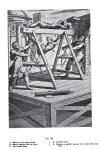
click to enlarge
Chapters:
1 -
2 -
3 -
4 -
5 -
6 -
7 -
8 -
9 -
10 -
11 -
12

Totally Faithful to the Sacred
Deposit of Faith entrusted to the Holy See in Rome
“Scio
opera tua ... quia modicum habes virtutem, et servasti verbum
Meum, nec non negasti Nomen Meum”
“I
know your works ... that you have but little power, and
yet you have kept My word, and have not denied My Name.”
(Apocalypse
3.8)
Copyright © 2004
- 2025 Boston Catholic Journal. All rights reserved. Unless
otherwise stated, permission is granted by the Boston Catholic
Journal for the copying and distribution of the articles
and audio files under the following conditions: No
additions, deletions, or changes are to be made to the text
or audio files in any way, and the copies may not be sold
for a profit. In the reproduction, in any format of any
image, graphic, text, or audio file, attribution must be
given to the Boston Catholic Journal.
|
|

